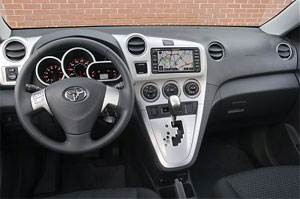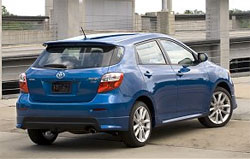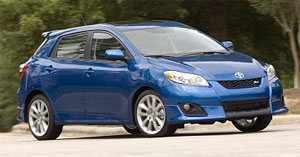2009 Toyota Matrix
When Toyota introduced the Matrix in 2003 it was a new concept. One vehicle that combined rally-car styling and youthful performance, with the versatility of an all-weather utility, and the drivability of a benchmark compact sedan. But the active lifestyle niche that the Matrix targeted is now quite crowded. So is this all-new, second generation 2009 Toyota Matrix still the trendy and tidy crossover to beat?
Nobody said being a segment leader is an easy job. Rivals quickly emerge, aiming to usurp the trendsetter, which then must respond by raising the bar even higher. And so it goes for the all-new second-generation 2009 Toyota Matrix, the youthful and lifestyle-driven compact crossover that now attempts to do just that.
To that end, the five-door Matrix now blends the crossover utility concept with even sportier, more coupe-like styling. It is now wider and lower than its predecessor, being a part of the redesigned Corolla family.
The more dynamic Matrix is spearheaded by a short sloping front-end and low profile-pointed headlamps. Down below, our uplevel XRS trim included deep-set fog lamps as well as front and rear underbody spoilers.
The Matrix’s rising profile leads back to a well-sculpted rear-end, featuring our tester’s rally-style roof spoiler.
Wheel sizes range from the base model’s 16 inchers to the XRS’ 18-inch alloys.
Inside, the five-seat cabin has also undergone a complete redesign, yet remains familiar and functional.
 The uniquely configured gauge cluster serves as the focal point to the driver centric cockpit design. Controls are large, chunky, and easy to operate.
The uniquely configured gauge cluster serves as the focal point to the driver centric cockpit design. Controls are large, chunky, and easy to operate.
The tilt/telescoping steering wheel offers available audio controls to command the optional JBL stereo system with nine speakers.
There’s even an available DVD navigation system with real-time traffic.
Seats have also been redesigned to match a lower ride height, without compromising comfort or visibility.
Occupant safety is provided by a rigid body structure as well as six airbags and active headrests.
The rear seat is still a tight fit for three, but roomy for two. The 60/40 split seatbacks fold easily, and as in the previous model, the front-seat folds flat for long items. Total cargo space is 49 cubic feet.
The Matrix shares most mechanicals with the Corolla, including two twin-cam variable timing engines. Base is a new 1.8-liter inline four-cylinder, outputting 132 horsepower and 128 pound-feet of torque. ‘S’ and ‘XRS’ models use the Camry’s 2.4-liter 4-cylinder with 158 horsepower and 162 pound-feet of torque.
Front-drive transmissions include four- and five-speed automatics, as well as a five-speed manual. An All-Wheel Drive system returns for the Matrix ‘S’ only.
Government Fuel Economy ratings for our manual Matrix XRS are 21 city/28 highway on regular gas. We managed an impressive 27.3 miles-per-gallon in real world driving.
On the track, our Matrix scooted from 0 to 60 in 7.9 seconds. It covered the quarter-mile in a respectable 16.2 seconds at 93 miles-per-hour. The Matrix hooks up well and takes off assertively. Its performance also benefits from well-spaced gears and short shifts throws.
Handling is defined by a MacPherson strut front suspension and two types of rear setups. The ‘Base’ and ‘S’ trim use a torsion beam. ‘S’ all-wheel drive and our ‘XRS’ sport double wishbone geometry. Stability and traction Control are added on the XRS.
 The Matrix is very nimble for it’s type, if not quite athletic. But it does deliver a fun driving experience, partially due to the loose nature of its back end. The electric power steering is well weighted with reasonable feedback. There is mild body roll and under steer, but nothing excessive or unsafe.
The Matrix is very nimble for it’s type, if not quite athletic. But it does deliver a fun driving experience, partially due to the loose nature of its back end. The electric power steering is well weighted with reasonable feedback. There is mild body roll and under steer, but nothing excessive or unsafe.
Halts come from standard four-wheel discs with ABS and Brake Assist. Stops were stable, but showed some fade, and averaged a typical 130 feet from 60 to 0.
Pricing for the Matrix is broad and affordable. The base model starts at $16,850, while the ‘S’ trim begins at $18,920. The well-equipped XRS starts at $21,320. As before, all key features are shared with the Pontiac Vibe, which adds standard OnStar and a longer power train warranty.
The 2009 Toyota Matrix has style, versatility, performance, and affordability. It has always had these attributes, but now enjoys an upshot of each, making it one of the most well-rounded and youth-friendly offerings on the road, again.
Specifications
- Engine: Xrs 2.4-Liter 4-Cylinder
- Horsepower: 158
- Torque: 162 Lb Feet
- 0-60 MPH: 7.9 Seconds
- 1/4 Mile: 16.2 Seconds @ 93 MPH
- 60-0 MPH: 130 Feet
- EPA: 21 MPG City/ 28 MPG Highway
- Mixed Loop: 27.3 MPG






